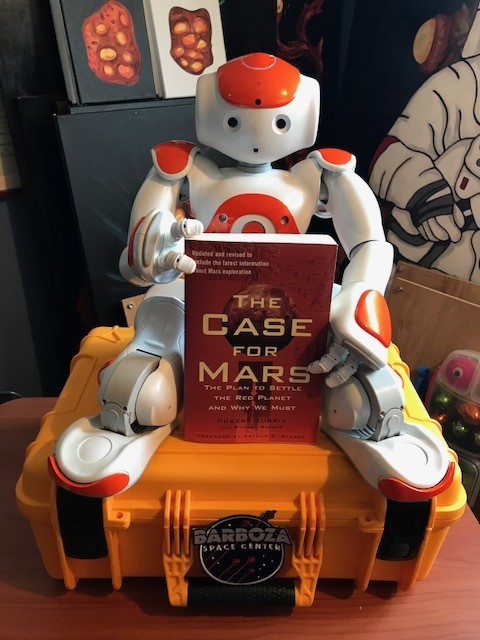The Case for Mars
By Robert Zubrin with Richard Wagner
Free Press (revised edition)
©1996 revised 2011
This book transformed my thinking about human travel to Mars.
Like every other space geek in 1996, I assumed humanity’s first voyage to the red planet would require a massive and super-expensive spacecraft that needed to be assembled in orbit. The project would be so big and complex it would have to be an international project—how could any one country afford the trillion-dollar price tag?
The international crew would consist of about a dozen astronauts (eleven was the number assumed in one NASA study) and the entire spacecraft would mass around one million pounds, most of that fuel—including fuel to lift-off from Mars and return to Earth.
It would be huge . . . complicated . . . and expensive.
So said the space experts.
Except for one contrarian: American aerospace engineer Dr. Robert Zubrin. Beginning in 1990, Zubrin and his colleagues at Martin Marietta Corporation put together a proposal called Mars Direct. This groundbreaking study reconsidered Mars exploration almost from scratch, throwing several sacred cow assumptions into the trash and describing an approach that would not only be faster and cheaper than the mega-projects, but just plain more doable.
Mars Direct overturned NASA’s assumptions in three main ways:
- The first voyages to Mars should be small and cheap, with four generalist astronauts, all of whom will explore the surface.
- They will manufacture all return fuel right there on the surface of Mars, using in-situ (on site) resources and well-established chemical processes, no “magic” required. This would enormously reduce the total mass of the required spacecraft—the first landing can be accomplished with only three launches.
- The best way to explore Mars is to go to Mars. There is no engineering or practical justification to spend time and money using the moon as “practice” for Mars. The best way to learn how to explore Mars is to go directly to Mars and start exploring!
The popular book The Case for Mars is Zubrin’s report to the public. As far as readability and scope of imagination, it rivals anything I’ve read by Carl Sagan or Arthur C. Clarke (who wrote the introduction for the original edition, by the way).
Zubrin builds his case methodically, every claim resting on facts and logic. He makes a special point to address common objections and concerns toward the exploration of Mars. What about radiation hazards, for example? What about the health hazards of weightlessness during the trip? If the explorers are gone from Earth two or three years at a time, wouldn’t they go insane?
And the thorniest objection of all: wouldn’t it be better if we just waited until space engineers developed some advanced technology that would make things easier and safer for our astronauts? Like nuclear plasma propulsion to reduce travel time. Or a space tower! Or robots to terraform Mars before we even get there! Shouldn’t we just wait?
Zubrin’s answer can be summarized thusly: Did Columbus wait for a steamship?
If you remember your high school or college chemistry (and even if you don’t) Zubrin supplies a detailed walkthrough of the manufacturing processes needed to obtain valuable commodities like water, oxygen, and methane fuel from the atmosphere of Mars. One of the most exciting facts about his narrative is that no scientific or engineering breakthroughs are required. We can go now, with what we have.
In the latter part of the book, Zubrin removes his engineering hat and discusses the benefits to our society of opening a true frontier—not just temporary “bases” for astronauts, but permanent and independent settlements. When the first edition of this book was published, Elon Musk was age twenty-five and working on his first startup company, an internet city guide for newspapers. No one was thinking in terms of settling Mars during our own lifetimes. That was something for the far future, for our grandchildren, probably using technology we can’t imagine.
But Zubrin shows us it’s not necessary to wait. And this case has become even more solid with the discovery in 2008 that Mars harbors far more available water (as ice and permafrost) than previously imagined—almost all over the planet.
I wish I could make this book required reading for every high school graduate in the United States.
Five stars – recommended for anyone interested in our future.



 Glenn Damato studied physics and astronomy at the University of Iowa. He served in the US Navy as a nuclear propulsion plant operator aboard an attack submarine. He has worked as a cook, a taxi driver, a car salesman, a loan officer, a debt collector, a technical support engineer, and a software instructor. A lifelong space and aviation enthusiast, he holds a pilot’s license and while at sea level he enjoys sailing. He is the author of the bestselling memoir Breaking Seas. The Far Shore is his first novel.
Glenn Damato studied physics and astronomy at the University of Iowa. He served in the US Navy as a nuclear propulsion plant operator aboard an attack submarine. He has worked as a cook, a taxi driver, a car salesman, a loan officer, a debt collector, a technical support engineer, and a software instructor. A lifelong space and aviation enthusiast, he holds a pilot’s license and while at sea level he enjoys sailing. He is the author of the bestselling memoir Breaking Seas. The Far Shore is his first novel.